
The
spinal cord
is a long cylinder of nervous tissue with subtle cervical and lumbar
(lumbosacral) enlargements. The enlarged segments contribute to the
brachial and lumbosacral plexuses. In the above image, showing a brain
and
spinal cord from a neonatal pig, the
spinal cord and
spinal roots are enveloped by dura mater.
The
spinal cord is divided into
spinal cord segments. Each segment gives rise to paired
spinal nerves. Dorsal and ventral
spinal roots arise as a series of rootlets. A
spinal ganglion is present distally on each dorsal root. The canine
spinal cord has 8 cervical, 13 thoracic, 7 lumbar, 3 sacral and 5 caudal segments. The following table compares species.
Spinal cord Segments and spinal Roots
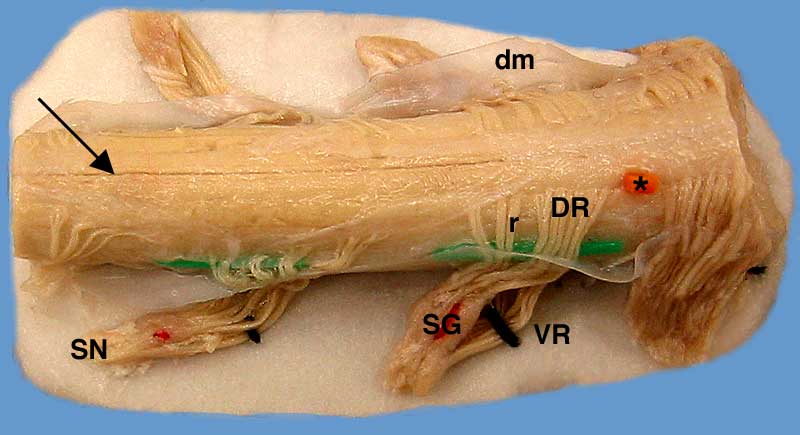
Dural mater (dm) is reflected to expose segments and roots in a length of equine
spinal
cord. The arrow points to the dorsal median sulcus. The orange pic
(asterisk) marks the dorsolateral sulcus, where dorsal roots enter the
spinal cord. Each
spinal cord segment gives rise to right and left dorsal and ventral
spinal roots. Each
spinal root is composed of rootlets (r). The dorsal root (DR) and the ventral root (VR) unite to form a
spinal nerve (SN). A
spinal ganglion (SG) is located distally on each dorsal root. Colored pics mark:
spinal
ganglia (red), the separation between dorsal and ventral roots
(black), and the location of the denticulate ligament. The specimen
rests on white cardboard.
Spinal
cord segments in different species (for reference purposes):
Dog: 8 cervical; 13 thoracic; 7 lumbar; 3 sacral; & 5 caudal = 36 total
Cat: 8 cervical; 13 thoracic; 7 lumbar; 3 sacral; & 5 caudal = 36 total
Bovine: 8 cervical; 13 thoracic; 6 lumbar; 5 sacral; & 5 caudal = 37 total
Horse: 8 cervical; 18 thoracic; 6 lumbar; 5 sacral; & 5 caudal = 42 total
Swine: 8 cervical; 15/14 thoracic; 6/7 lumbar; 4 sacral; & 5 caudal = 38 total
Human: 8 cervical; 12 thoracic; 5 lumbar; 5 sacral; & 1 coccygeal = 31 total
The
spinal cord and
spinal
roots are enveloped by meninges and housed within the vertebral canal.
The epidural space, situated between the wall of the vertebral canal
and the
spinal dura mater, contains a variable amount of fat. Within dura mater, the
spinal cord
is suspended by bilateral denticulate ligaments and surrounded by
subarachnoid space filled with cerebrospinal fluid. Dorsal and ventral
spinal roots unite to form
spinal
nerves which exit the vertebral canal at intervertebral foramina. An
intervertebral foramen is formed by adjacent vertebrae and by the
intervertebral disc joining the vertebrae.
The
spinal cord and
spinal
roots are enveloped by meninges and housed within the vertebral canal.
The epidural space, situated between the wall of the vertebral canal
and the
spinal dura mater, contains a variable amount of fat. Within dura mater, the
spinal cord
is suspended by bilateral denticulate ligaments and surrounded by
subarachnoid space filled with cerebrospinal fluid. Dorsal and ventral
spinal roots unite to form
spinal
nerves which exit the vertebral canal at intervertebral foramina. An
intervertebral foramen is formed by adjacent vertebrae and by the
intervertebral disc joining the vertebrae.
As a result of differential growth of the spinal cord and vertebral column, most spinal cord segments are positioned cranial to their nominally corresponding vertebrae. However, spinal segment length is variable along the spinal cord
in our domestic mammals. Segments become progressively shorter from
the C3 to T2. Then they elongate so that segments at the thoracolumbar
junction are within nominally corresponding vertebrae. Thereafter,
segments progressively shorten until the cord terminates in a terminal filament of glia. (The term "conus medullaris" refers to the cone-shaped cord region between the lumbosacral enlargement and the glial filament.)
Since
spinal nerves exit the vertebral canal at nominally corresponding intervertebral foramina,
spinal roots must elongate when
spinal cord segments are displaced cranially. The term cauda equina (horse tail) refers to caudally streaming
spinal
roots running to intervertebral foramina in the sacrum and tail.
Damage to the cauda equina affects pelvic viscera and the tail. Cauda
equina epidural anesthesia (putting anesthetic into the epidural space
to block conduction in
spinal roots) is a common obstetrical procedures in cattle.
Because vertebrae can be palpated and visualized in ordinary radiographs, unlike
spinal segments, it is clinically useful to know locations of
spinal cord
segments relative to vertebrae. Typically (for most dogs) the cervical
enlargement is centered at the C6-7 intervertebral disc;
spinal
segments of the thoracolumbar junction are within nominally
corresponding vertebrae; the sacral segments are within vertebra L5; and
the functional
spinal cord terminates at the L6-7 vertebral junction. (Termination is about one vertebra further caudally in small dogs, less than 7 kg.)
Spinal cord Within Vertebral Canal
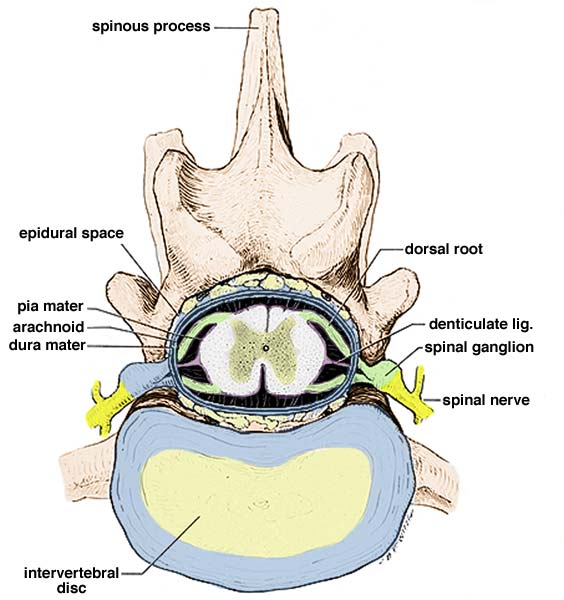
The following drawing depicts a
spinal cord segment within a lumbar vertebra, at the level of an intervertebral disc (nucleus pulposus surrounded by annulus fibrosus).
spinal
nerves are present bilaterally at intervertebral foramina, dorsal to
the disc. An epidural space, containing fat, is evident external to
spinal
dura mater (blue). The latter is shown surrounding roots on the left;
it is removed on the right side. Bilaterally, dorsal and ventral
spinal roots (green) unite to form a
spinal nerve (yellow) which soon branches. Bilateral thickenings of pia mater (purple), called denticulate ligaments, suspend the
spinal cord within the dura mater.
spinal cord In Situ
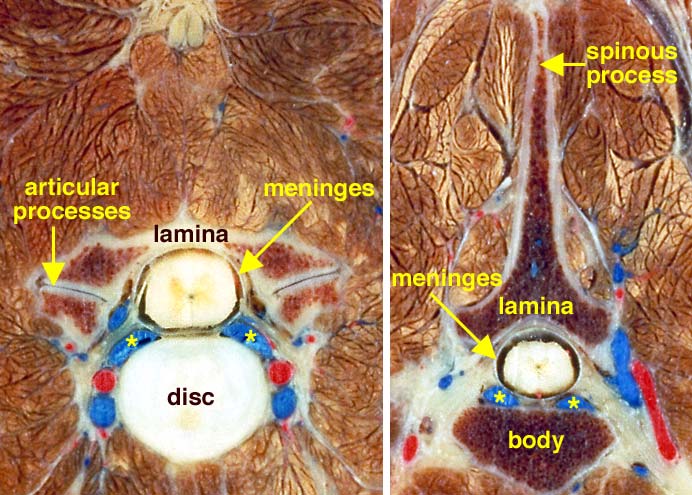
Left: Cervical transection through an intervertebral disc (nuchal ligament at the top). The
spinal
cord, surrounded by meninges, is evident within the vertebral canal.
Internal vertebral venous sinus is marked by asterisks. (Vertebral a.
& v. are visible bilaterally.)
Right: Thoracic vertebra transection. The
spinal cord is surrounded by meninges within the vertebral canal. Internal vertebral venous sinus is marked by asterisks.
Canine spinal Cord
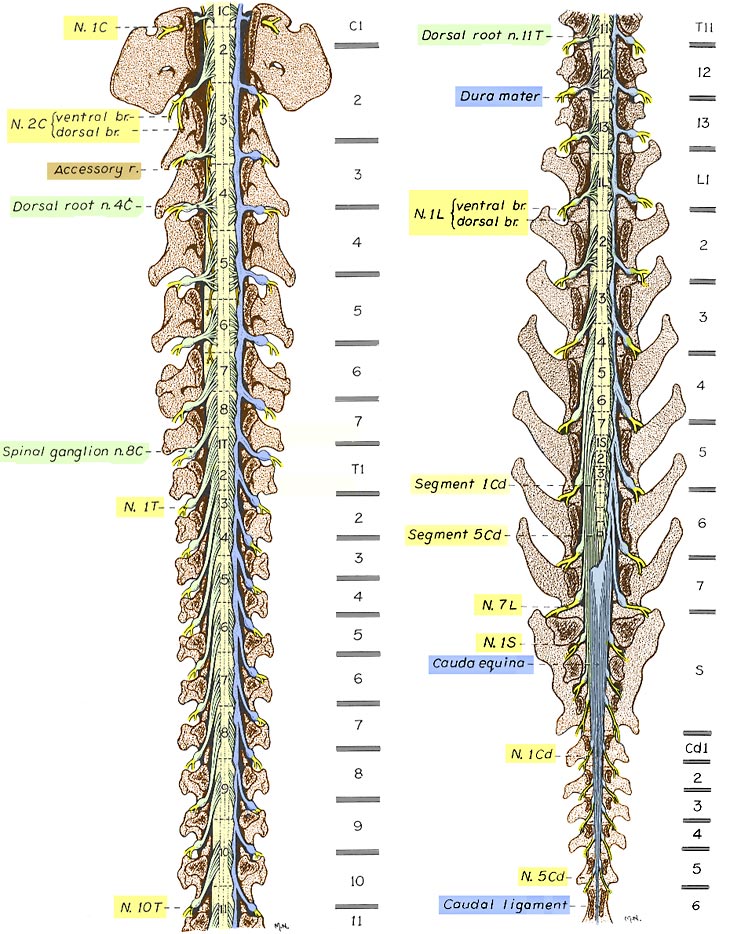
Cranial and caudal halves of a canine vertebral column are illustrated, after a laminectomy to expose the
spinal cord.
Spinal cord segments are labeled, and locations of vertebral bodies separated by intervertebral discs are shown to the right.
Dura mater (blue) has been removed except along the right side. The illustrated position relationship of
spinal cord
segments to vertebrae represents the most common relationship for
medium and large dogs (typical variation is half a vertebral length
cranial or caudal to that shown). In small dogs (under 7kg)
spinal cord segments are positioned more caudally than is shown.
Canine spinal cord — Cranial Half
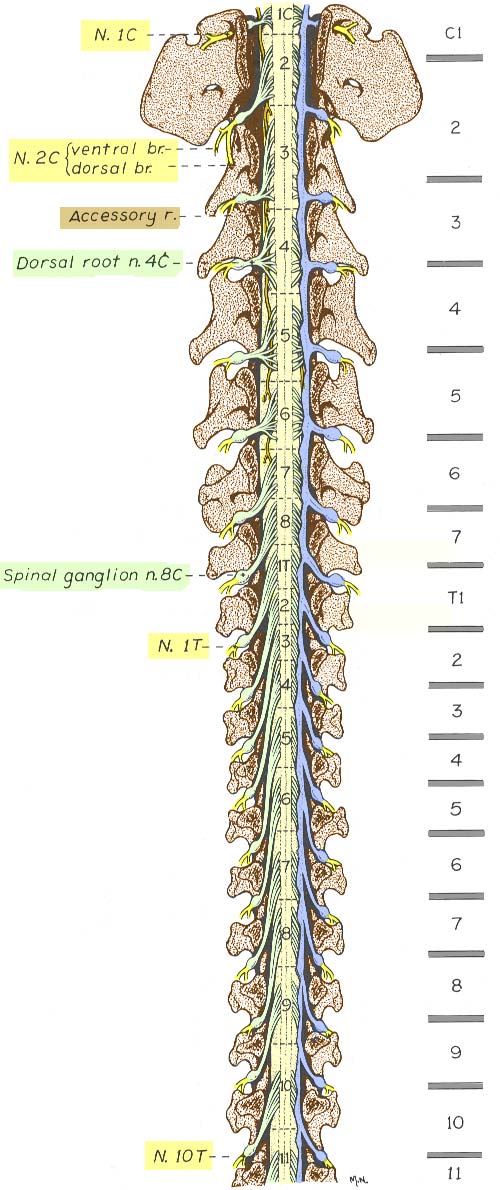
The cranial half of a canine vertebral column has been drawn after a laminectomy to expose the
spinal cord.
spinal cord segments are labeled and locations of vertebral bodies separated by intervertebral discs are labeled to the right.
Dura mater (blue) has been removed except along the right side. Dura mater envelops
spinal roots including
spinal ganglia.
Notice that
spinal segments vary in length and that
spinal
roots must elongate to reach intervertebral foramina where segments
are shifted cranially. In the cervical region, notice that the
spinal root of the accessory cranial nerve (Accessory r., tan) emerges laterally, between dorsal and ventral roots. The C1
spinal nerve (N.1C, yellow) exits from a lateral foramen, rather than an intervertebral foramen like other
spinal nerves. The C8
spinal segment appears to be "extra" (it lacks a nominally corresponding vertebra). Thus, caudal to the cervical region,
spinal nerves exit through intervertebral foramina located at caudal margins of nominally corresponding vertebrae.
The C3 segment is the longest. Thereafter, segments progressively
shorten in length. After the T2 segment, segments progressively
lengthen. The cervical enlargement (C6, 7, 8, & T1) which innervates
the thoracic limb (brachial plexus) is centered approximately at the
C6-C7 intervertebral disc.
Canine spinal cord — Caudal Half
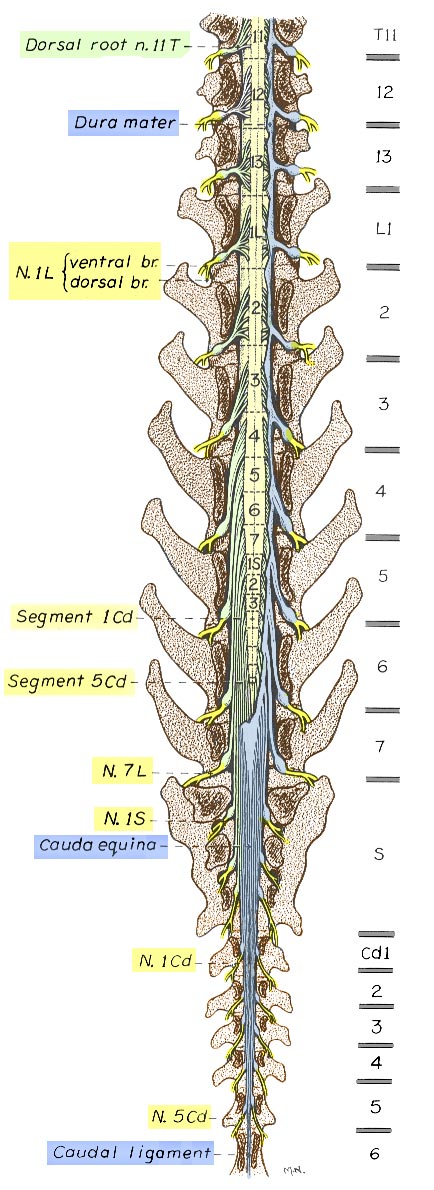
The cranial half of a canine vertebral column has been drawn after a laminectomy to expose the
spinal cord.
spinal
cord segments are labeled and locations of vertebral bodies separated by intervertebral discs are labeled to the right.
Dura mater (blue) has been removed except along the right side. Dura mater envelops
spinal roots including
spinal ganglia.
Notice that thoracolumbar
spinal
segments are long and located within nominally corresponding
vertebrae. Thereafter, segments progressively shorten in length and
spinal
roots elongate as segments shift position cranial to nominally
corresponding vertebrae. Sacral and caudal roots streaming caudally are
referred to as the cauda equina. Notice that the cauda equina is
initially intrathecal (within the main cylinder of
spinal dura mater); thereafter, the roots are enveloped by dural sheaths in the epidural space.
The term conus medullaris refers to the cone-shaped region of
spinal cord caudal to the lumbosacral enlargement (L4 — S1). The
cord
terminates approximately at the L6-L7 intervertebral disc. Thereafter a
terminal filament of glial tissue continues for some distance. The term
caudal ligament refers to the terminal filament enveloped by a dural
sheath.
Canine spinal cord Termination
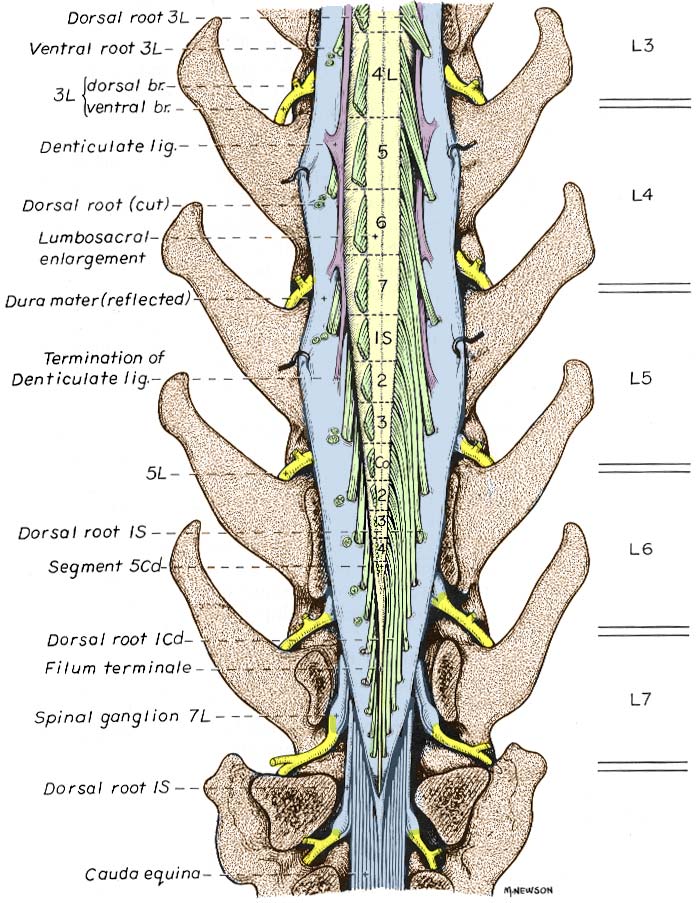
Illustration of a canine
spinal
cord termination. A laminectomy was performed and dura mater has been reflected to expose
spinal
cord segments and
spinal
roots. Dorsal roots are cut on the left side to expose the denticulate
ligament (purple). Notice the termination of the denticulate ligament;
the cauda equina; and the terminal filament (filum terminale), a glial
continuation persisting beyond the functional end of the
spinal cord. The illustrated position of the
spinal
cord
termination at the L6-L7 intervertebral disc represents the most
common relationship for medium and large dogs (varying plus or minus a
half vertebra). In small dogs (under 7 kg) the typical position is one
vertebra caudal to that shown.
Spinal Cord—Vertebrae Relationships
It is clinically useful to know the approximate locations of
spinal
cord
segments relative to palpable, radiographically visible vertebrae. One
learning strategy is to remember the following four relationships and
then interpolate other position relationships as necessary. (The
illustrated relationships are the most common for medium and large dogs (
half vertebra). In small dogs the position is one vertebra caudal to
that shown.)
A. The cervical enlargement (brachial plexus segments) are centered at the C6-C7 intervertebral disc.
B. At the thoraco-lumbar junction, segments are positioned within nominally corresponding vertebrae.
C. The three sacral segments are located within the L5 vertebra.
D. The
spinal cord terminates at the L6-L7 intervertebral disc























